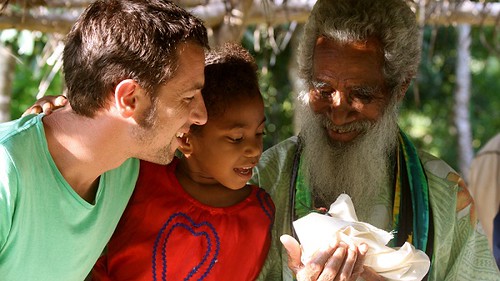 Veterinarian Antoine Barnaud with Ouvea Island’s Aizik Wea, his granddaughter and an Ouvea parrot. Image by: Bethany JacksonNew Caledonian rainbow lorikeets infected with avian circovirus could act as a disease source, threatening native and endangered New Caledonian parrot populations.
Veterinarian Antoine Barnaud with Ouvea Island’s Aizik Wea, his granddaughter and an Ouvea parrot. Image by: Bethany JacksonNew Caledonian rainbow lorikeets infected with avian circovirus could act as a disease source, threatening native and endangered New Caledonian parrot populations.
Researchers identified avian circovirus in the rainbow lorikeets (Trichoglossus haematodus deplanchii) after testing the blood and feather samples of four species of New Caledonian parrot, including the endangered Ouvea parakeet (Eunymphicus uvaeensis).
Around 2000 Ouvea parakeets remain in the wild, where they are restricted to New Caledonia's Ouvéa Island.
"Our concern would be that [the virus] might spill over from the lorikeets into that small population," says Dr Bethany Jackson, project leader and researcher with Murdoch University's School of Veterinary and Life Sciences.
Dr Jackson says efforts by New Caledonian community groups have turned the Ouvea parakeet into a conservation success story, but exposure to the incurable virus could undermine these results.
"The traditional owners are protecting the birds. They've gone from being critically endangered to only in the threatened category," she says.
 Dr Bethany Jackson and local vet Antoine Barnaud test for avian circovirus in an Ouvea parrot. Image by: Steve Murphy"Now we're concerned these lorikeets may be a secondary threat, by bringing in a disease that [Ouvea parakeets] may not have been exposed to."She says finding evidence that the Ouvea parakeet population has already been exposed to PBFD would reduce the threat.
Dr Bethany Jackson and local vet Antoine Barnaud test for avian circovirus in an Ouvea parrot. Image by: Steve Murphy"Now we're concerned these lorikeets may be a secondary threat, by bringing in a disease that [Ouvea parakeets] may not have been exposed to."She says finding evidence that the Ouvea parakeet population has already been exposed to PBFD would reduce the threat.
Avian circovirus, also known as beak and feather disease virus, causes psittacine beak and feather disease (PBFD) and infects wild and aviary birds around the world.
"The second might be to do more testing in the Ouvea parakeet. We only captured a small number of birds, so we can't confidently say [the virus] is not there."ought to have originated in Australia, PBFD is nicknamed 'avian AIDS'.
"One option would be to consider culling them," Dr Jackson says.ne of the major ways this virus affects parrots is by reducing their immunity to other diseases," Dr Jackson says.
To further conservation work, locals are developing a biosecurity program for Ouvéa Island. Part of that plan will be options for controlling the rainbow lorikeets, which were introduced to the island in the 1970s. "Young birds tend to die very rapidly. Older birds may develop a long-term lack of immunity. They end up succumbing to other illnesses."
Avian circovirus, also known as beak and feather disease virus, causes psittacine beak and feather disease (PBFD) and infects wild and aviary birds around the world.
Thought to have originated in Australia, PBFD is nicknamed 'avian AIDS'.
"One of the major ways this virus affects parrots is by reducing their immunity to other diseases," Dr Jackson says.
"Young birds tend to die very rapidly. Older birds may develop a long-term lack of immunity. They end up succumbing to other illnesses."
As part of the study, Dr Jackson's team worked with local people to facilitate future work.
"We taught them how to mist net the birds safely, we taught the local vet how to anesthetise the birds, we had meetings with the chiefs of the different tribes."
To further conservation work, locals are developing a biosecurity program for Ouvéa Island. Part of that plan will be options for controlling the rainbow lorikeets, which were introduced to the island in the 1970s.
"One option would be to consider culling them," Dr Jackson says.
"The second might be to do more testing in the Ouvea parakeet. We only captured a small number of birds, so we can't confidently say [the virus] is not there."
She says finding evidence that the Ouvea parakeet population has already been exposed to PBFD would reduce the threat.
of the study, Dr Jackson's team worked with local people to facilitate future work.
"We taught them how to mist net the birds safely, we taught the local vet how to anesthetise the birds, we had meetings with the chiefs of the different tribes."
To further conservation work, locals are developing a biosecurity program for Ouvéa Island. Part of that plan will be options for controlling the rainbow lorikeets, which were introduced to the island in the 1970s.
"One option would be to consider culling them," Dr Jackson says.
"The second might be to do more testing in the Ouvea parakeet. We only captured a small number of birds, so we can't confidently say [the virus] is not there."
She says finding evidence that the Ouvea parakeet population has already been exposed to PBFD would reduce the threat.
Read more at: http://phys.org/news/2014-08-avian-aids-virus-poses-threat.html#jCp
Read more at: http://phys.org/news/2014-08-avian-aids-virus-poses-threat.html#jCp
Read more at: http://phys.org/news/2014-08-avian-aids-virus-poses-threat.html#jCp